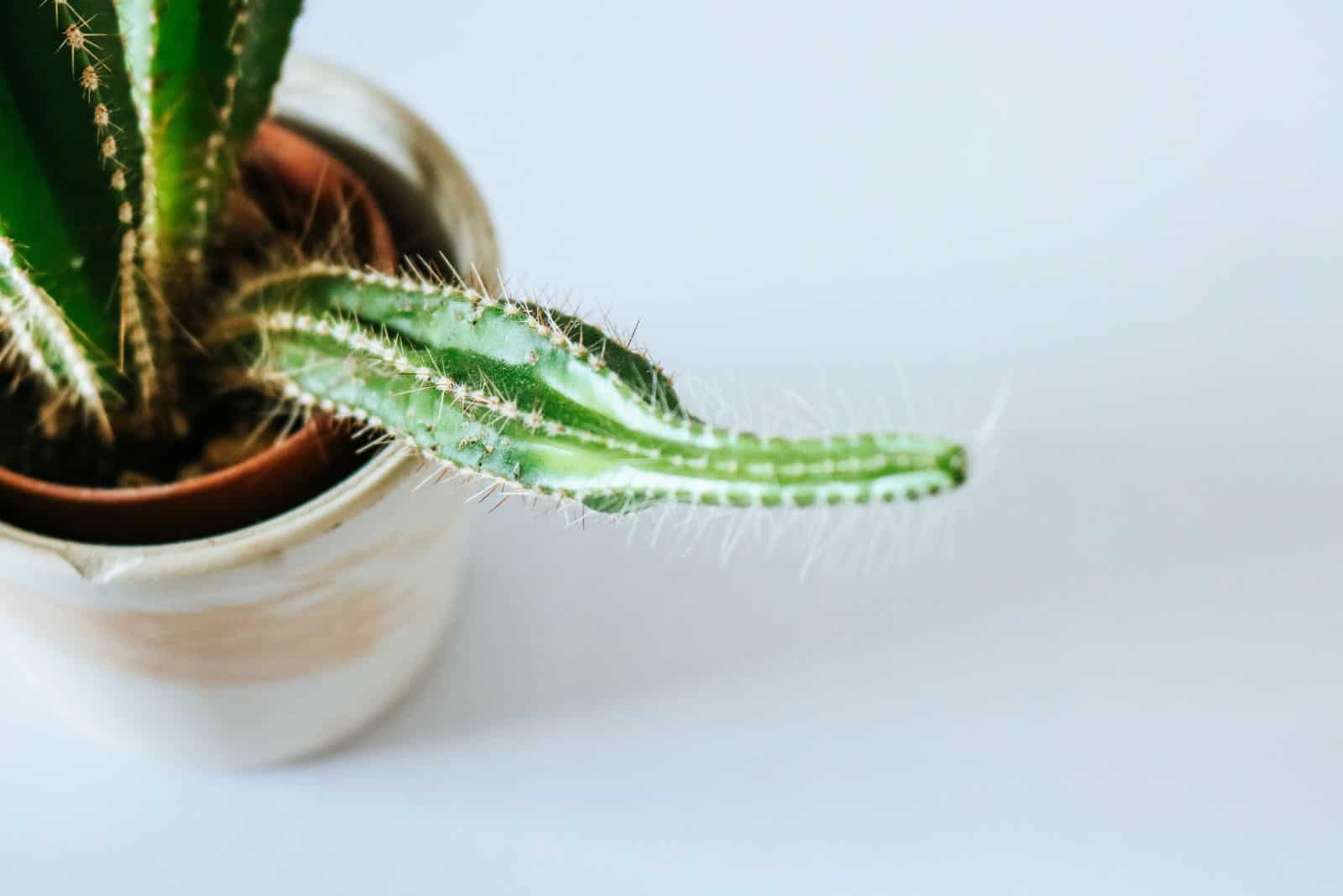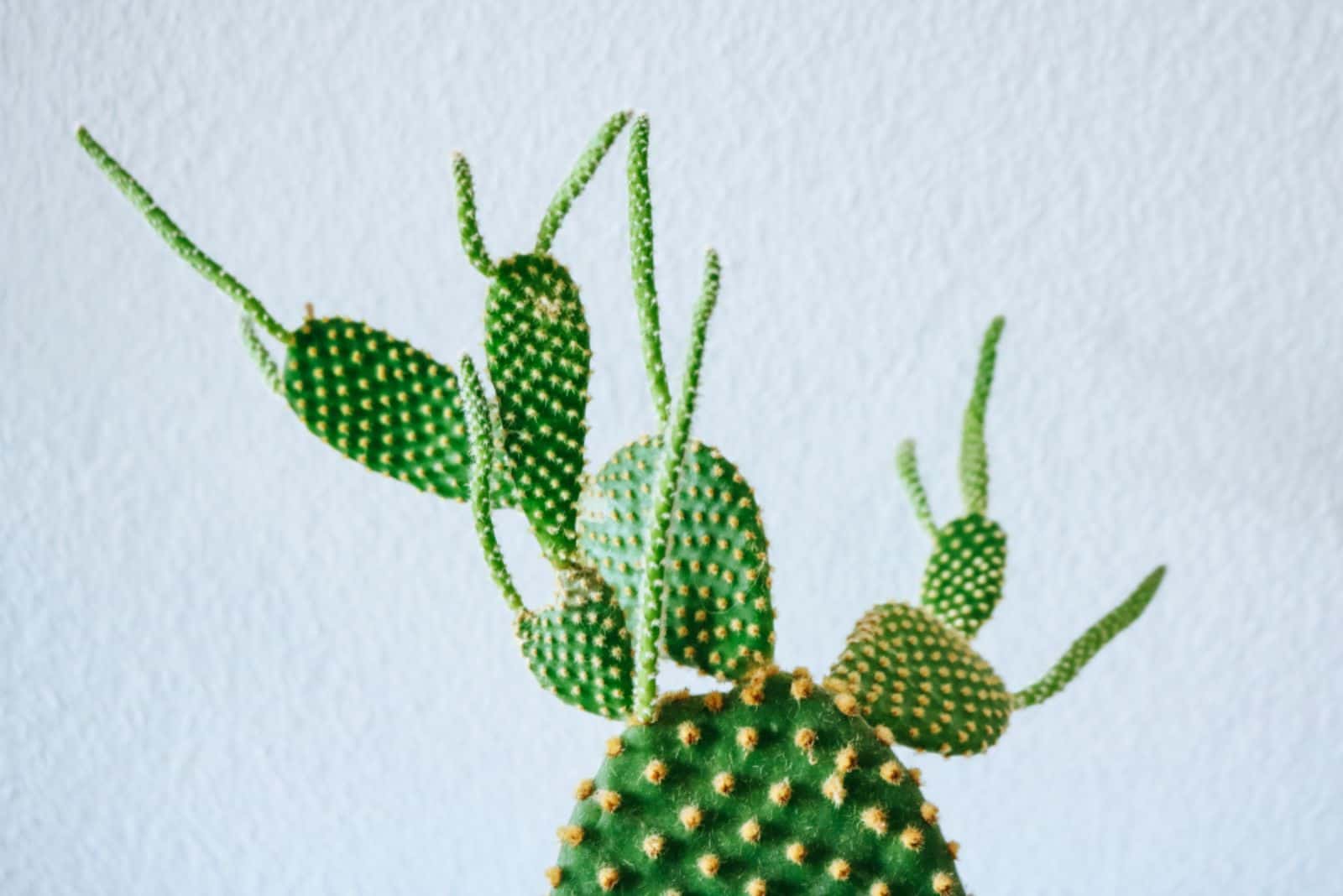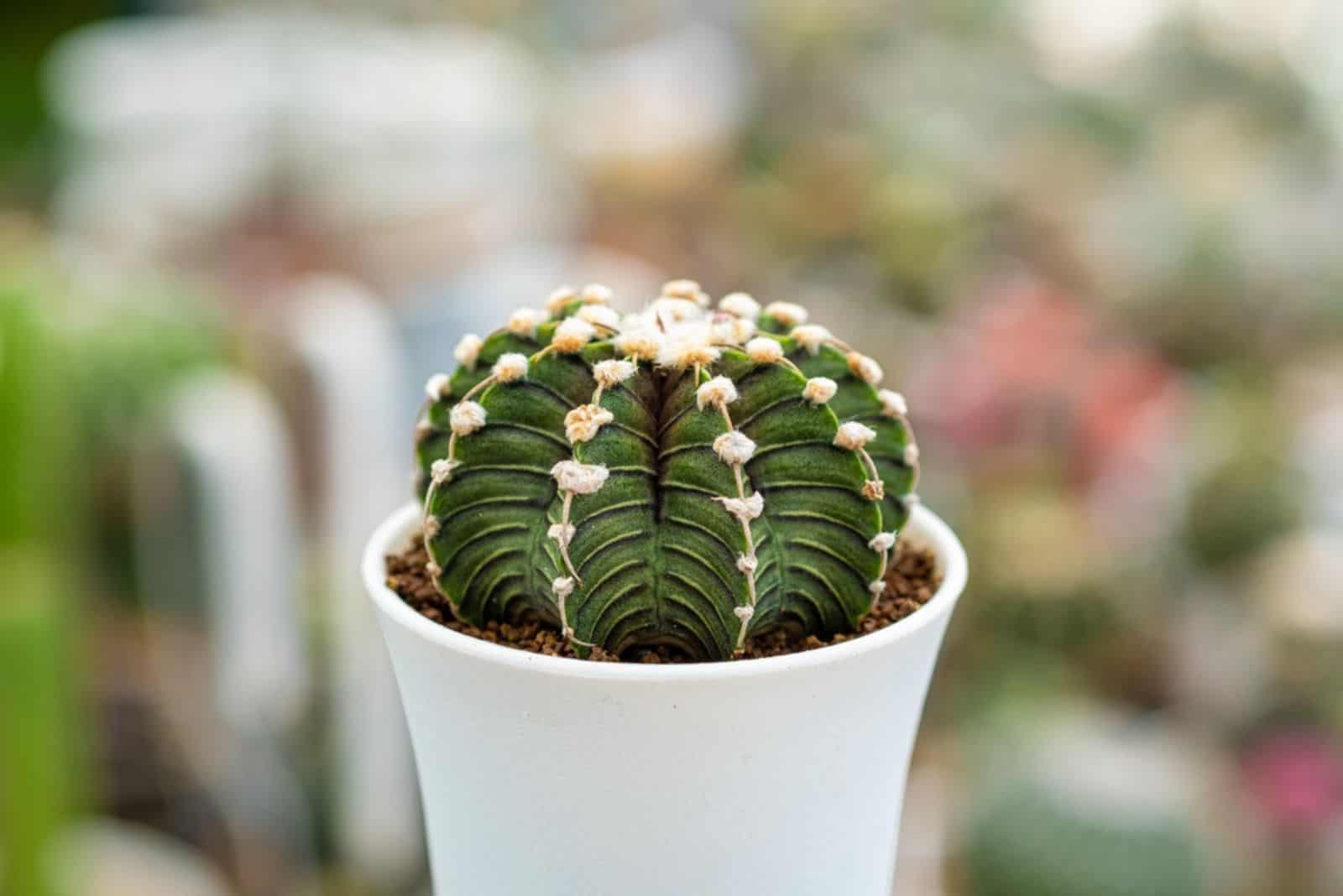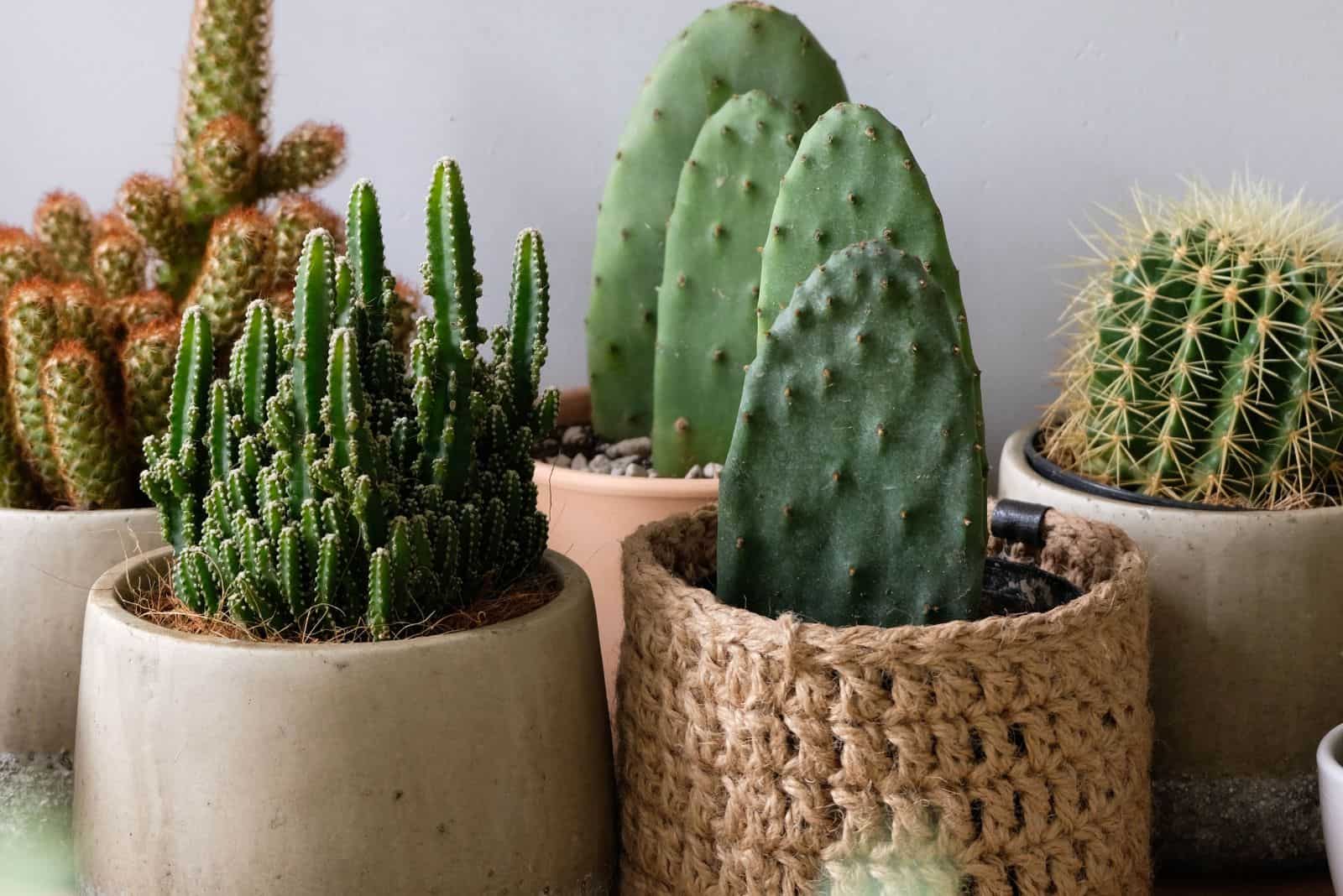When we talk about cactus plants, we often think of them as impossible to kill.
These are succulent plants and their care requirements are very low, so we are very surprised when we see something isn’t OK with our cacti.
Contrary to popular belief, cactus etiolation isn’t uncommon and it happens way more than we think.
The thing is that this condition won’t instantly kill your cactus, but its appearance will be far from perfect as a result.
In this article, I’ll tell you how to know if your cactus is etiolated and the most common causes of this condition.
I’ll also show you the best ways to treat this problem and how to avoid it in the future.
Let’s get started!
The Signs Of Cactus Etiolation
So, what does an etiolated cactus look like?
First of all, your cactus may start developing at an unusual rate. It may also become pale and stop producing blossoms. The stems typically get malformed and the plant stretches toward the light source.
If you notice these signs, you are dealing with etiolation in your cactus plant.
Let’s get into details!
Cactus Stretches Towards The Light Source
If your cactus is growing faster than usual and it seems like it wants to reach the light, you are dealing with etiolation.
Your cactus is actually focusing all its energy in order to get more light, so it loses its original shape.
Interestingly, this is a great survival strategy, as your cactus doesn’t want to give up and will do its best to get some light.
Stretching is most noticeable in cactus species that have a round shape, such as the Barrel cactus.
The leaves of the Prickly pear cactus (Opuntia spp.) are typically oval in shape, but if the plant is etiolated, the leaves become more pointy.
Discoloration
One of the most frequent signs of etiolation in succulents is discoloration. This refers to the loss of the original colors of specific succulent and cactus species.
If your cactus isn’t getting enough light, it can’t produce chlorophyll, which is what gives plants their green color.
As a result, your succulent plant won’t perform photosynthesis and will display poor growth.
If your cactus turns pale green, it might be etiolated.
The Absence Of Flowers
These are flowering plants, and if given enough light and food, they’ll produce lovely blossoms during their growing season.
For etiolated cacti, we have a different scenario. If your plant suffers from this condition, it won’t reach the flowering stage.
Why is this so? In order to produce blossoms, plants need a lot of energy, and the only way to restore energy is by receiving enough light and food.
I have to mention that etiolation isn’t the primary cause of the absence of blossoms, so you need to inspect your cactus closer to make sure something else isn’t happening.
Deformation Of Spines
When these succulent plants display etiolated growth, their spines will drift away from one another.
The spines may also become narrower or even fall off.
When we touch our cacti (of course with gloves for cacti), some spines may fall off, but that’s completely normal.
However, if this plant species starts losing the spines without being disturbed, then it might be etiolated.
The Causes Of Cactus Etiolation
Cactuses are definitely among the most sun-loving plants. When grown as houseplants, they need a lot of sun exposure to thrive.
They are also desert plants, so their watering needs are very low. If you live in a cold region, your cactus needs to rest over winter. If it doesn’t, etiolation may occur.
Let’s discuss the causes in detail!
Not Enough Light
As previously stated, cacti enjoy full sun. Some species adapt well to lower light conditions, but they can’t display healthy growth if they don’t receive enough light.
If your cactus needs more light, it will stretch toward the light source, which will result in a loss of shape.
Therefore, it is crucial to learn the lighting needs of cacti & succulents before bringing them inside, and to put them somewhere with enough light.
Direction Of The Light
Another important thing to understand is that the direction of the light, i.e., the point from which your cactus receives light, also plays a major role in healthy growth.
Cacti and other similar plants will reach for neighboring windows or other light sources in order to receive more light.
If you put your plants close to windows, you should occasionally rotate their containers. For instance, you can slightly rotate them when you water them.
This way, you’ll avoid tilting and your lovely cactus will preserve its original shape.
Absence Of Hibernation
Your cactus needs to sleep if you live in an area with long and harsh winters.
Dormancy is an important part of the lifecycle of these plants.
If you encourage growth with fertilization, frequent watering, and warmer temperatures, your cactus will be wide awake during the winter months, but the growth will be etiolated.
Your cactus will develop thin stems and elongated growth if you don’t induce dormancy.
Keep reading to find out the best ways to induce dormancy in these plants.
Low Humidity
If your cactus doesn’t display normal growth, your might want to check the humidity levels.
If they don’t receive enough humidity and they lack light, their growth will be significantly inhibited.
You need to be careful about the frequency of irrigation, as lack of light and low humidity may decrease cactus watering needs even more.
Overfeeding
If plants are given an excessive amount of fertilizer, they will become fragile, which could lead to them gaining too much weight and leaving them unable to support themselves.
The truth is that you’ll promote root development, but if your cactus doesn’t receive enough light it will keep growing, and as a result become etiolated.
Therefore, fertilization isn’t always necessary and could cause more harm than good.
How To Treat Etiolated Cactus Plants
You’ve now seen how to recognize etiolation in plants from the Cactaceae family. Once you determine what has caused etiolation in your plant, you should start treating it.
The most important thing is to expose your plant to more light, but if that doesn’t work, you can also try changing its fertilizing and irrigation schedule, adjusting the temperature, pruning or repotting it, or growing a species that doesn’t require as much light.
Increase Sun Exposure
Unfortunately, you can’t just relocate your cactus and expose it to direct sunlight immediately. Yes, I know it would be the easiest method, but your cactus won’t respond to this very well.
Sudden full sun exposure will cause sunburns on the foliage.
You should gradually increase the amount of light your cactus plant receives. Move it to the new spot first, and keep it there for a few hours before bringing it back to the original location.
Increase sun exposure every day until your cactus can stay in that location all day.
The majority of cacti prefer full sun, so try to put them near south-facing windows so they get enough sunlight without being burned.
Rotation is another excellent way to give your lovely cactus enough sun exposure.
Use Grow Lights
Sometimes, it may be challenging to ensure the correct light conditions for indoor plants. Many growers can’t provide spots near sunny windows, which results in insufficient lighting for their houseplants.
The good news is that you can use artificial lights for your etiolated plants in order to compensate for the lack of sunlight.
Make sure you install grow lights above your cactus so that the entire plant receives enough light.
Prune Your Cactus Plant
Pruning is generally the best choice if you can tell that your cactus won’t be capable of recovering from etiolation.
Also, if weaker growth on the top of the plant can’t sustain new development, it would be best to cut it off.
Cacti can be pruned by simply removing any extra growth. Your cactus will most likely develop one or two babies after trimming.
This is an excellent way to get cuttings for propagation, and also get more plants for your succulent collection.
With the right cactus care, roots can develop into robust plants.
Induce Dormancy
Although inducing dormancy might sound like rocket science, trust me when I say it isn’t!
It simply refers to changing the growing conditions for your houseplants. As mentioned, warm temperatures and feeding may prolong the growing season, so you need to adjust these factors to induce hibernation.
For instance, you can relocate your cactus to somewhere temperatures are slightly lower. Make sure that the temperatures aren’t too low because you may shock your plant.
When relocating, pay attention to the lighting conditions in that area.
Changing your fertilizing schedule can also help you induce dormancy. These plants aren’t heavy feeders, but they’ll benefit from a nutrient boost from time to time.
As far as the fertilizer type is concerned, the best idea would be to use one specifically designed for succulent and cacti species.
You can start adding nutrients at the beginning of spring, i.e., when your cactus displays new growth.
Stop feeding your cactus when fall approaches; remember that it prolongs the growing season and your cactus needs a good sleep.
Water More/Less Frequently
Watering desert plants can be pretty challenging, but if you allow their growing medium to dry out between waterings, you are on the right path.
You can encourage new growth by irrigating your cactus more frequently during the growing season.
As for etiolated cacti, you might want to irrigate less or even stop watering during the colder months.
If your cactus lacks humidity, consider growing it in a succulent terrarium.
Repot Your Cactus
Repotting is an excellent way to give cactus plants a fresh start. If your cactus becomes leggy, you might want to check its roots, as they most likely don’t have enough space to spread.
When purchasing a pot for your cactus, go with a slightly larger pot and make sure it has holes in the bottom. Remember that large pots hold more water and increase the chances of overwatering.
Fill the container halfway up with a growing substrate, put your cactus in, and add more soil to cover the root system.
Choose Less Light-sensitive Cactus Plants
If you are a beginner and want to add a new plant to your succulent collection, you might want to choose a less light-sensitive cactus species.
Some cacti, such as the San Pedro or Mexican giant cardon cactus (yes, you can grow them indoors), look very attractive; however, their light requirements may be higher, so I recommend the following varieties.
1. Mistletoe cactus: Interestingly, this species has a vining growth habit, which is pretty uncommon for cacti. Elongated and thin leaves make this cactus unique and perfect for every plant collection.
It doesn’t require a lot of full sun exposure, so there’s one more reason to grow it.
2. Holiday cactus: All types of Holiday cacti aren’t finicky about lighting conditions. Bright indirect light will make your Holiday cacti happy and healthy.
3. Fishbone cactus: This is a unique species that is cultivated for its distinctive angular, serrated stems. It performs well in lower light conditions, which means it doesn’t get etiolated quickly.
Can You Fix Cactus Etiolation?
The bad news is that your cactus won’t go back to normal after being given more light or changing its other growing conditions.
The only way to restore the shape is by pruning. Luckily, you can use the sections you removed for propagation.
Once you remove the leggy part of your etiolated cactus, you can replant it. Make sure you use adequate substrate for cactus plants.
Don’t worry; this condition won’t kill your cactus. The best thing you can do is meet all its plant care requirements.
So, if you grow an Easter lily cactus, Prickly pear, Golden barrel, or Blue myrtle cactus, follow their care guides to avoid etiolation or any other issue.
Wrapping Up
When I started growing succulents, my cactus became etiolated, so I understand your concern.
Cactus etiolation results in legginess, discoloration, and the absence of blossoms. Remember that the most common cause of this condition is insufficient lighting, so the treatment is related to fixing sun exposure.
You can prune, relocate, and rotate your cactus, or install artificial lights. Remember that the correct growing conditions will prevent etiolation, so meet all the cactus requirements to avoid potential issues.
Good luck and until next time!





